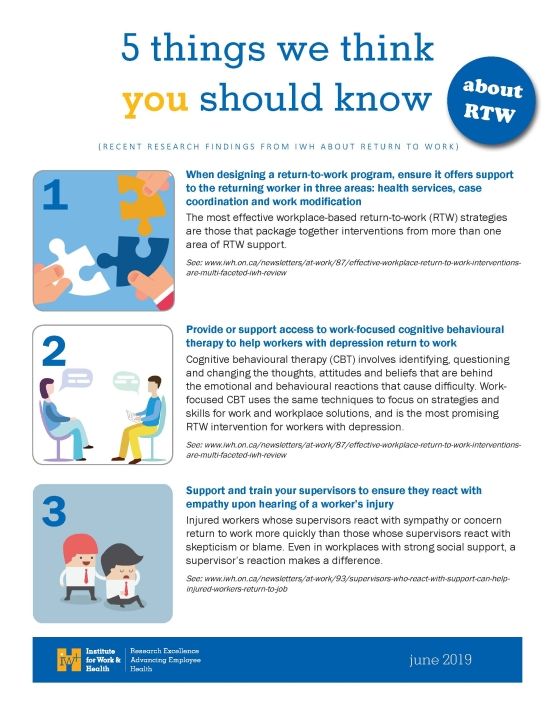
When designing a return-to-work program, ensure it offers support to the returning worker in three areas: health services, case coordination and work modification
The most effective workplace-based return-to-work (RTW) strategies are those that package together interventions from more than one area of RTW support.

Provide or support access to work-focused cognitive behavioural therapy to help workers with depression return to work
Cognitive behavioural therapy (CBT) involves identifying, questioning and changing the thoughts, attitudes and beliefs that are behind the emotional and behavioural reactions that cause difficulty. Workfocused CBT uses the same techniques to focus on strategies and skills for work and workplace solutions, and is the most promising RTW intervention for workers with depression.

Support and train your supervisors to ensure they react with empathy upon hearing of a worker’s injury
Injured workers whose supervisors react with sympathy or concern return to work more quickly than those whose supervisors react with skepticism or blame. Even in workplaces with strong social support, a supervisor’s reaction makes a difference.

Offer a variety of workplace benefits and accommodations to proactively support older workers with chronic conditions
Boomers with diabetes, arthritis and other chronic conditions benefit from support programs such as flex time, work-at-home arrangements and extended health benefits. Although older workers with chronic conditions don’t use these programs any more than their healthy peers, when these programs are available to them and are used before a health crisis occurs, they have fewer job disruptions, work limitations and productivity losses than those who don’t have access to these programs.

Make a cost-benefit case for hiring and accommodating people with mental illness at your workplace
Employers stand to gain $2 to $7 for every $1 spent on accommodating a worker with mental illness. For the accommodated worker, the benefit ranges from $4 to $12 for every $1 spent. And that’s not counting those intangible benefits that are too difficult to put a dollar value on.
